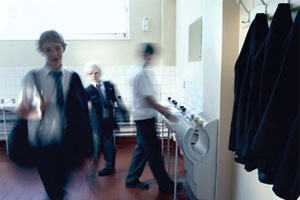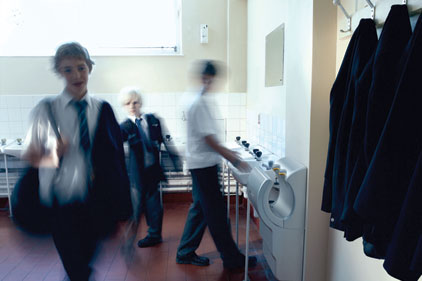Seemingly every day, there is an incident at the grammar, middle or high school which calls for quick action from a school or district security official as well as clear, fast, accurate communications to the appropriate stakeholders ranging from parents, students, and teachers to law enforcement and the media.
The incident could be life safety related, especial since many schools are older buildings. A case in point this winter, 13 students and a staff member were

|
|
A growing number of schools report threats left or written in bathrooms. In balancing privacy with security, some schools have positioned security cameras outside of bathroom doors to capture images in forensics use. Photo courtesy Dyson |
evacuated from Putney Central School in Putney, Vt., after a boiler malfunctioned and sent fuel fumes into the school. Ambulances from around Windham County responded to the school just before noon after students and staff said they smelled gas in the building. All of the staff and students were moved to the gymnasium where a number of people received preliminary blood tests.
There are also a growing number of security-related incidents in which security tends to be beefed up while administrators rely on mass notification systems to get the word out. Many of these incidents are triggered by an email warning or writing on a bathroom wall.
For example, security was recently tightened at a small Texas school district after a threat was made to students. Almost half of the students in Bay City schools were out of classes for a number of days after officials disclosed an anonymous letter writer threatened to kill students unless “bleeding heart liberals” cracked down on discipline. According to the superintendent, the district’s schools locked all exterior doors and additional police patrols were added.
Then there are the pranks, often ripped off of movies or TV scenarios, which can disrupt the learning experience and put people at risk.
For instance, people thought they heard gunshots at North Mecklenburg High School in North Carolina recently when a potentially dangerous homemade device went off within 20 feet of a police officer. The bangs came from a cafeteria trash can, in which someone had placed two plastic water bottles containing a mixture that included a common household substance. The chemical combination produced gas inside the bottles that caused the pressure to build up and eventually blow off the bottle caps.
In another recent incident, students were evacuated from Hillside Middle School in Manchester, N.H.for two consecutive days after bomb threats were discovered written on bathroom walls. Both threats – one in a boys’ bathroom and the other in a girls’ bathroom – indicated a date and time a bomb would explode. Officials are considering strict requirements for use of bathrooms, including having a staff member escort students to the bathroom. Under one possible plan, a staff member would wait outside the bathroom and then inspect it after a student uses it. In some other school districts, security video is positioned outside the bathroom doors for forensics if threats are left inside.
Still, there remain old-fashioned methods of clearing a school. After an assembly at the Hillside Middle School about the bomb threats, someone pulled a fire alarm, which caused an evacuation.
Student’s Facebook Page Ends with Goodbye; Then He Shoots Two, Kills Himself

|
|
While Mark Zuckerberg was recently named Time Magazine’s Person of the Year, his Facebook social Web site sometimes is used by students to post threats to schools or to document troubling messages. Some school security executives and law enforcement officials suggest that these sites might one day be a source for early warnings of potential school violence incidents. Photo courtesy Time Magazine |
Oh, what Mark Zuckerberg has wrought when he helped invent Facebook? Or are these social sites a new early warning sign for schools fighting the potential of violence? What happened earlier this year in an Omaha high school is both rare and tragic. But the incident underlines government and industry research that shows there are often warning signs before the gunfire begins. The son of a police detective opened fire at the high school, fatally wounding the assistant principal and forcing panicked students to take cover in the kitchen of the building just as they returned from holiday break. The gunman, who had attended the school for no more than two months, also wounded the principal before fleeing from the scene and fatally shooting himself in his car. The vice principal died at a hospital hours after the shooting. In a rambling Facebook post filled with expletives, the shooter warned days earlier that people would hear about the “evil” things he did and wrote that the school drove him to violence. He wrote that the Omaha school was worse than his previous one, and that the new city had changed him. He apologized and said he wanted people to remember him for who he was before affecting “the lives of the families I ruined.” The post ended with “goodbye.”
As part of its National Threat Assessment Center, the U.S. Secret Service has a Safe School Initiative, a study of school shootings and other school-based attacks that was conducted in collaboration with the U.S. Department of Education. The study examined school shootings in the United States as far back as 1974 and involved extensive review of police records, school records, court documents and other source materials, and included interviews with school shooters.
The study found that school shootings are rarely impulsive acts. Rather, they are typically thought out and planned in advance. In addition, prior to most shootings, other kids knew the shooting was to occur but did not alert an adult. Very few of the attackers, however, ever directed threats to their targets before the attack. The study findings also revealed that there is no “profile” of a school shooter; instead, the students who carried out the attacks differed from one another in numerous ways. Still, almost every attacker had engaged in behavior before the shooting that seriously concerned at least one adult and, for many, had concerned three or more different adults.
The findings from the study suggest that some school attacks may be preventable, and that students can play an important role in prevention efforts. Using the study findings, the Secret Service and Department of Education modified their threat assessment approach for use in schools to give school and law enforcement professionals tools for investigating threats in school, managing situations of concern, and creating safe school climates.



